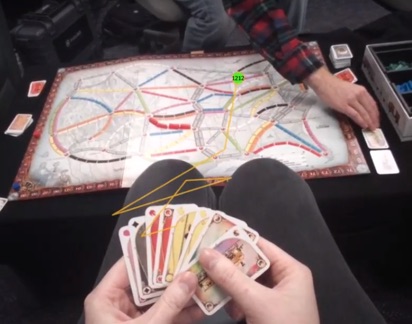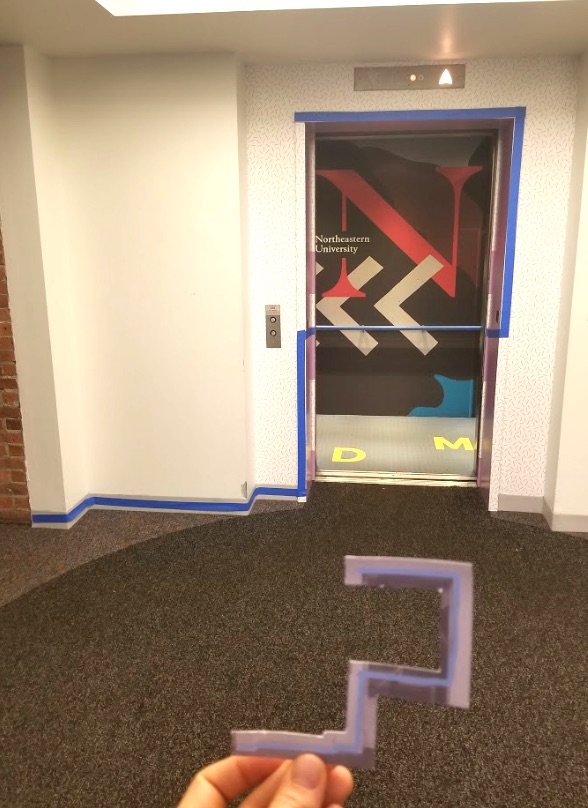Alex Coburn is a student in CAMD’s Master of Science Game Science and Design program, where he is currently working on his thesis that involves studying mental processes that occur while playing a board game. We recently caught up with Alex about the incredible work he has done on his thesis so far, his experience in the Game Science and Design (GSND) program, and what he aspires to do in his career. Read more about it below.
Tell us more about your board game thesis project.
My thesis uses both the physical and digital versions of the popular board game, Ticket to Ride, to study the effect that the game medium itself has on cognitive processes. To do this, I am using eye tracking glasses to measure different actions of the participants’ eyes, such as pupil dilation, fixation length, and gaze patterns. These are then used to determine the level of working memory and mental inhibition used by the brain while playing the game. I ran my experiment with 10 participants in the Experiential Technologies Lab, where they played both the digital and physical copies of the game for 12 minutes against me. I sat across from them while we played the tangible board game, and played on a computer in an adjacent observer room while players used a laptop for the digital version of the game. My hypotheses for the effects on working memory and inhibition are based on the differences between the two versions. For instance, the digital rendition has a helpful user interface (UI) that automates many aspects of the game, like scoring, which may reduce the working memory load. Using literature-backed and heuristic reasoning, I hypothesize that players will use more working memory resources while playing the digital game, while they will exhibit more inhibition while playing the physical version of it. When my data collection has been completed, I will see if the data supports these hypotheses.

What made you want to pursue your M.S. in Game Science and Design?
When I decided to apply to the Game Science and Design graduate program, I was working as a data assurance associate at PwC; a job that I got through the co-op program when I was an undergraduate in Northeastern’s D’Amore-McKim College of Business. I had worked there for almost two years when I finally decided that I needed to make a career change to pursue my passion and desire to create positive change through games. While attaining my undergraduate degree, I minored in Game Design, so I was fortunate enough to know several members of the staff in the program already. What made me ultimately accept the offer to join the program was the course load that has an emphasis on theory and would enable me to study some of the psychological aspects of play.
Tell us about what you hope to do with your degree.
I hope to make a positive, lasting impact on the world using games. I would be happy to work for a game company that makes serious games for educational, medical, or training purposes. My research experience in the GSND program has prepared me to work in a game-related lab or in a game research role at any game company. Further down the line, I’d love to work for school districts or educational game organizations where I could embed games in K-12 school curricula; I know the many benefits games provide in learning environments. Eventually, I would also like to start my own educationally-focused game company creating tabletop and other physical games.
Any highlights during your time as a master’s student here?
One of the greatest qualities of this program is that it has given me experience and chances to grow in both game design and research. In my design courses with Chris Foster and Chris Barney, I have worked on many projects that have enabled me to push past my boundaries as a designer. I created an origami-inspired board game in my first year that I’m currently working on converting into an alternate reality (AR) game with my teammates. We submitted it for a grant program at Magic Leap and plan to show it at PAX East this year at the Northeastern booth. In my Spatial and Temporal Design class, I created a world in Minecraft that told a complete story with just its environment. I also took Exploratory Concept Design, where I worked on several games of which I am very proud. One of these included a real-world version of a popular first-person puzzle game, The Witness. This involved our team setting up blue strips of painter tape all over Ryder Hall for our players to line up. The puzzle in the photo below required players to open the elevator doors to connect the blue line.

Aside from my thesis, I have worked with Casper Harteveld and Christoffer Holmgard on building my quantitative, qualitative, and mixed methods research skills. I have gotten multiple opportunities to build experiments in Harteveld’s StateCrafter, which makes creating digital experiments quick and easy. I’ve studied ADHD using custom-built diagnostic mini-games, and I’ve studied loot boxes using biometric measurements in iMotions software. As the program continues to grow and develop, even more tools and resources like iMotions and the Experiential Technologies Lab will become available for future student research, which I find very exciting.


